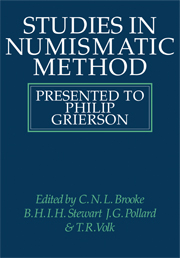Book contents
- Frontmatter
- Contents
- Acknowledgements
- Abbreviations
- Philip Grierson's contribution to numismatics
- A bibliography of the writings of Philip Grierson
- Introduction
- 1 Thoughts on the beginnings of coinage
- 2 The life of obverse dies in the Hellenistic period
- 3 Roman coinage of the Cyrenaica, first century bc to first century ad
- 4 Roman imperial coin types and the formation of public opinion
- 5 Coin hoards and Roman coinage of the third century AD
- 6 Belgian finds of late fourth-century Roman bronze
- 7 The re-use of obsolete coins: the case of Roman imperial bronzes revived in the late fifth century
- 8 Interpreting the alloy of the Merovingian silver coinagae
- 9 Carolingian gold coins from the Ilanz hoard
- 10 The novi denarii and forgery in the ninth century
- 11 On the rejection of good coin in Carolingian Europe
- 12 Ælfred the Great's abandonment of the concept of periodic recoinage
- 13 King or Queen? An eleventh-century pfennig of Duisburg
- 14 Personal names on Norman coins of the eleventh century: an hypothesis
- 15 The Gornoslav hoard, the Emperor Frederick I, and the Monastery of Bachkovo
- 16 Coinages of Barcelona (1209 to 1222): the documentary evidence
- 17 Finds of English medieval coins in Schleswig-Holstein
- 18 Privy-marking and the trial of the pyx
- 19 Judicial documents relating to coin forgery
- 20 Mint organisation in the Burgundian Netherlands in the fifteenth century
- 21 Coinage in Andrew Halyburton's Ledger
- 22 Imitation in later medieval coinage: the influence of Scottish types abroad
- 23 Barter in fifteenth-century Genoa
- Index
20 - Mint organisation in the Burgundian Netherlands in the fifteenth century
Published online by Cambridge University Press: 05 May 2010
- Frontmatter
- Contents
- Acknowledgements
- Abbreviations
- Philip Grierson's contribution to numismatics
- A bibliography of the writings of Philip Grierson
- Introduction
- 1 Thoughts on the beginnings of coinage
- 2 The life of obverse dies in the Hellenistic period
- 3 Roman coinage of the Cyrenaica, first century bc to first century ad
- 4 Roman imperial coin types and the formation of public opinion
- 5 Coin hoards and Roman coinage of the third century AD
- 6 Belgian finds of late fourth-century Roman bronze
- 7 The re-use of obsolete coins: the case of Roman imperial bronzes revived in the late fifth century
- 8 Interpreting the alloy of the Merovingian silver coinagae
- 9 Carolingian gold coins from the Ilanz hoard
- 10 The novi denarii and forgery in the ninth century
- 11 On the rejection of good coin in Carolingian Europe
- 12 Ælfred the Great's abandonment of the concept of periodic recoinage
- 13 King or Queen? An eleventh-century pfennig of Duisburg
- 14 Personal names on Norman coins of the eleventh century: an hypothesis
- 15 The Gornoslav hoard, the Emperor Frederick I, and the Monastery of Bachkovo
- 16 Coinages of Barcelona (1209 to 1222): the documentary evidence
- 17 Finds of English medieval coins in Schleswig-Holstein
- 18 Privy-marking and the trial of the pyx
- 19 Judicial documents relating to coin forgery
- 20 Mint organisation in the Burgundian Netherlands in the fifteenth century
- 21 Coinage in Andrew Halyburton's Ledger
- 22 Imitation in later medieval coinage: the influence of Scottish types abroad
- 23 Barter in fifteenth-century Genoa
- Index
Summary
In his concise handbook of Numismatics Philip Grierson has devoted a chapter to the making of coin. In it he gave a masterly survey of coinage methods from classical antiquity to the present day. In this essay I would like to exemplify some aspects of the making of coin in the later Middle Ages by a case study of the organisation of the mints of the fifteenth-century Netherlands. I have taken my information from the period after the unification of the coinages of the Low Countries by Philip the Good in October 1433.
The fifteenth century was not a period of rapid change and development in mint administration. The major medieval innovations in mint organisation had already taken place: in the thirteenth century Italians had developed individual mints to a ‘factory’ scale, and in the fourteenth century the French had evolved a system for the general administration of groups of mints. This study is therefore concerned with the portrayal of a mature and fully evolved system of mint organisation. Only minor modifications in structure were made during the two-thirds of a century under discussion. The stability in the forms of mint management lasted much longer than this period, for the organisation described here for these mints in the fifteenth century bears a marked resemblance to that described by other authors for the late fourteenth century for the mint of Flanders, and for the late sixteenth century for the mint of Antwerp.
- Type
- Chapter
- Information
- Studies in Numismatic MethodPresented to Philip Grierson, pp. 239 - 262Publisher: Cambridge University PressPrint publication year: 1983
- 18
- Cited by



